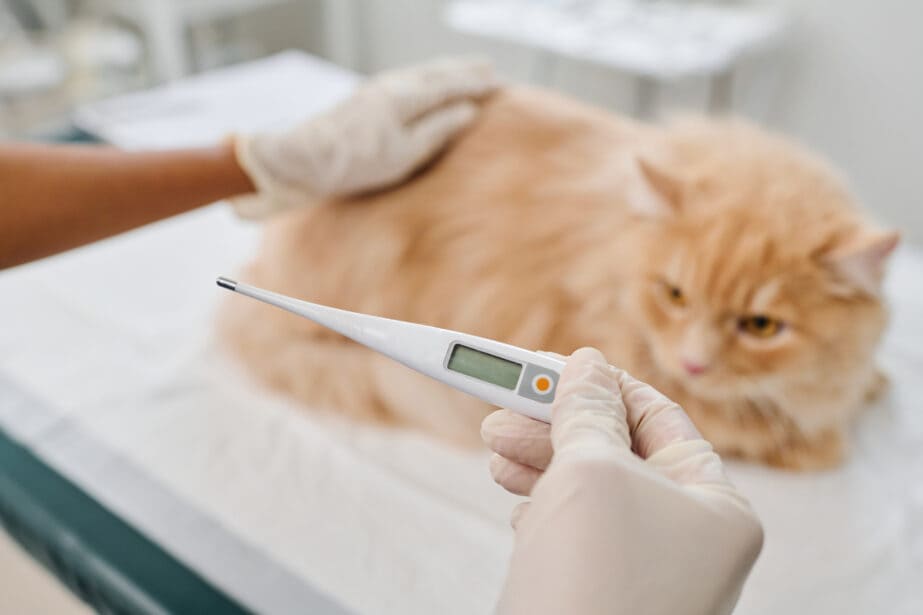When your cat isn’t feeling well, it can be hard to tell if they have a fever, especially since they’re experts at hiding their discomfort. Knowing how to tell if your cat has a fever is important, as it could be a sign of an underlying health issue.
We talked to some experts to learn how to detect a fever in cats, what the normal cat temperature should be, and when to seek veterinary care.
In This Guide:
What Is a Fever in Cats?
When a cat has a fever, it’s like when humans have one: the body’s natural response to fight infection or inflammation. The hypothalamus, a part of the brain, acts like a thermostat, raising the body’s temperature to help combat the illness.
The normal body temperature for cats is typically between 100 and 102.5 Fahrenheit.
“A fever could be considered if a cat has a temperature above 102.5,” says Dr. David Israel, medical director of the Veterinary Emergency Group in Denver. If the temperature exceeds 103 degrees, it’s worth contacting your veterinarian, and if it goes over 106 degrees, it’s considered an emergency.
Dr. Carlye Rosen, a veterinarian and clinical lead for IndeVets, notes that not all elevated temps are considered fevers.
Hyperthermia, which is also a raised body temperature, can happen due to external factors.
“In the case of heatstroke, physical activity, or seizure, the body hasn’t changed its set temperature point and therefore it isn’t defined as a fever,” she explains.
Common Cat Fever Symptoms
Cats often hide their symptoms, which can make detecting a fever tricky. Here are some common signs to watch out for that might indicate your cat is running a fever:
- Lethargy or decreased energy levels
- Loss of appetite
- Hiding or seeking solitude
- Warm paws or ear tips
- Behavioral changes, such as being more clingy, aggressive, or overly vocal
- Other symptoms of infection (e.g., nasal discharge, red eyes, vomiting)
You are the best gauge for telling if your cat is acting out of the ordinary. If you notice any sudden changes in their behavior, it’s best to reach out to their vet for a checkup.
What Causes a Cat Fever?
A variety of factors can cause fevers in a cat, ranging from infections to inflammatory diseases. Here are some of the most common causes:
Infections
Bacterial, viral, or fungal infections commonly cause fevers in cats, with the body raising its temperature to fight off the infection. “In a recent study, the leading cause of fever in cats was FIP, or feline infectious peritonitis,” Dr. Rosen adds.
Inflammation
Conditions like pancreatitis can cause fever without an infection. This happens when the body’s immune system reacts to inflammation in the organs, rather than fighting off an illness.
Autoimmune diseases
Sometimes the body’s immune system mistakenly attacks itself, which can trigger a fever. Although rare in cats, autoimmune conditions like systemic lupus, pemphigus, and stomatitis can all cause an elevated body temperature.
Medications
Dr. Israel explains that certain medications can cause fever. “For example, painkillers such as opioids can sometimes cause the body temperature to rise,” he says. Vaccines can also cause a fever as a side effect or a sign of an allergic reaction. These fevers are usually mild and should resolve on their own in a few days, but if one persists, it’s best to have your cat seen by the vet.
Post-surgery fever
“Cats who have undergone surgery can sometimes have a low-grade fever in the postoperative period,” Dr. Israel says. If the fever increases or doesn’t go away after they come home, contact your vet to make sure your cat hasn’t developed an infection.
Unknown causes
In a small percentage of cases, the cause of the fever can’t be found, even after many diagnostic tests. This is called a fever of unknown origin (FUO) and typically comes and goes in cats with no known cause.
How To Tell If Your Cat Has a Fever
The most accurate way to determine if your cat has a fever is to take their temperature with a rectal thermometer. Common ear thermometers for humans can be used in a pinch, but keep in mind this may not be as accurate for pets as they are for people. Axillary temperatures (under the armpit) are not very accurate either.
While some pet parents may hesitate to try taking their cat’s temperature at home, it’s a pretty straightforward process—if your kitty cooperates. Dr. Israel suggests having a second pair of hands to hold your cat while you check their temp. It’s important to use a lubricant on the thermometer to make sure you don’t cause any irritation or harm.
Dr. Israel also adds, “If you’re concerned about your cat’s symptoms enough to want to take their temperature, they should probably have them seen by a veterinarian.” Even if the thermometer doesn’t show a fever, your cat can still be sick.
When To Call Your Vet
If your cat’s temperature is over 102.5 F or if they’re showing symptoms like lethargy, vomiting, diarrhea, or a lack of appetite, it’s time to talk to your vet. “If the fever is severe, an emergency visit is strongly recommended,” Dr. Rosen says.
Your vet will likely do a physical exam, ask for a thorough history of the symptoms, and run diagnostics like blood work to try to find the cause of the fever. Treatment would be geared toward treating the underlying problem, alleviating the symptoms, and making sure your cat is comfortable and hydrated.
Dr. Rosen notes that a subnormal temperature—a temperature below 99 degrees—can also be a sign of illness and should warrant a vet visit.
Treating Fever in Cats
Depending on the cause of your cat's fever, your vet may prescribe medication or fluids to treat them. You can also help keep your cat hydrated while they have a fever by making sure they have access to plenty of water bowls or a water fountain.
How To Tell If Your Cat Has a Fever FAQs
Q:Can you tell if a cat has a fever by touching?
A:No; touch isn’t reliable for detecting fever in cats. Since their temperatures naturally run warmer than humans and their fur insulates them, it’s easy to misjudge. Checking their paws or ears might give you a clue, but a thermometer is still the best way to accurately check for a fever.
Q:How do you tell if your cat has a fever without a thermometer?
A:While it's challenging to determine a fever without a thermometer, common signs include lethargy, loss of appetite, and behavioral changes like hiding or being overly vocal. A vet visit is recommended if your cat shows any of these symptoms.
Q:Can you tell if a cat has a fever by feeling their ears?
A:While your cat’s ears may feel warm, this isn’t a reliable way to check for a fever. Cats naturally have higher body temperatures than humans, so their ears can feel warm even if they don’t have a fever.
Q:What can I give my cat for a fever?
A:Never give human medications like ibuprofen or acetaminophen to your cat. These common fever-reducing meds are poisonous for cats and can be life-threatening if ingested. Instead, Dr. Rosen suggests applying a cool, damp cloth to your cat’s paws and abdomen and putting them in front of a cooling fan. Then make an appointment for them to be seen by a vet as soon as possible.
Share:














